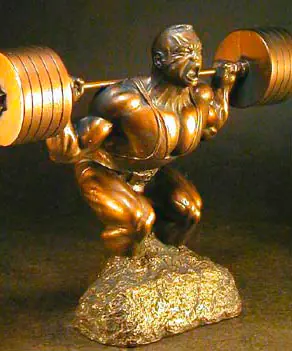If we have the right to come to training in anything, relying only on common sense, our own tastes and preferences, then in a situation with competitions the situation is completely different. Your sports suit, as well as shoes, belts, wristbands, supports, pads and other necessary equipment for powerlifting are subject to strict control from the outside judges. Even in the most modest competitions at the local level, at best you will be forced to change clothes, and at worst, you may be counted as a defeat and disqualify.
Content- What are the requirements for clothing, shoes, belts and other accessories?
- Sports equipment for powerlifting used in competitions
- Additional accessories, personal belongings of athletes
What are the requirements for clothing, shoes, belts and other accessories?
Competitors perform in a single one-piece single-layer suit made of elastic material, without additional patches or pads of any color(s). The seams and their hems should not be more than 3 centimeters in width and half a centimeter in thickness, which should be taken into account in squats.
A shirt of any color with short sleeves (about two inches above the elbow) can be worn under the elevator operator's suit. You cannot perform in a ribbed, rubberized shirt with pockets, buttons, or zippers. The collar of outerwear may contain a round or pointed neckline.
Should be worn under the lifting suit sports underwear (briefs in the form of swimming trunks) or regular pants (cotton or nylon), but always made of single-layer material.
Women have the right to wear protective panties or similar panties, if their elements are not supportive, as well as a bra that does not contain wires or support devices.
You are allowed to perform in socks of any color, not rubber or tight-fitting.
Judges' clothing - dark blue jacket, gray trousers, white shirt, tie.
Powerlifting Shoes and Belt
A powerlifting belt with a buckle attached to one end can be worn over the lifter's suit. The maximum width of the belt is 10 cm, the maximum thickness is 13 mm, while the buckle must have an internal width of no more than 11, and an external width of no more than 13 cm.
Participants perform in training gymnastic slippers, sports shoes, boots or any other footwear that has a sole without metal spikes or pads.
Bandages and Bandages for Powerlifting
You can use bandages or bandages for industrial powerlifting made from single-layer elastic, with cotton, polyester or a combination coating. Bandages made of rubber or its substitutes are prohibited. The length of the bandage for the arms is no more than a meter, the width is 8 cm, for the knees: the length is 2 m and the width is 8 cm. Combinations of bandages and knee pads are prohibited.
Do not use a patch, bandage or bandage to help hold the barbell.
1 hour before the official weigh-in, two judges inspect the costumes. At the request of the judge, the athlete is obliged to replace an element of equipment that does not meet the requirements of the rules.
Additional accessories, personal belongings of athletes
Watches, jewelry, glasses and feminine hygiene items are not subject to inspection.
It is strictly prohibited to use oils, grease or other lubricants on the skin of the body, suit or personal equipment and equipment, except for powder consisting of chalk, talc, rosin, magnesium carbonate.
Now you know what clothing and other accessories lifters should wear during competition. Well, in the off-season you have the right to wear whatever your heart desires; Personally, lately I prefer M1 clothes - stylish things from the world-famous fight club. If you are really strong, and any obstacles are not an obstacle for you, then such clothes are exactly what you need! Declare yourself loudly! Like a real winner! Isn’t this what the opposite sex values most about us? Nobody likes losers. Girls like real winners!
Post Views: 355


